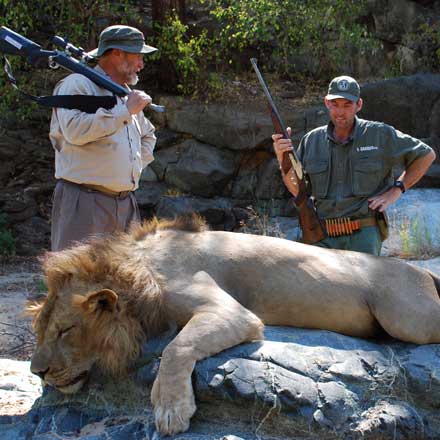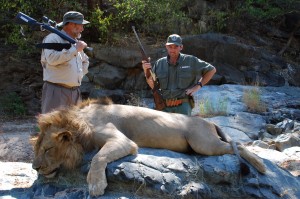
Resurrected by Ruger and Federal in 1988, it’s an article of faith today that the .416 Rigby was one of the most popular of the British big bores. Historical records do not bear this out. Introduced in about 1911, the .416 Rigby was long held as a proprietary cartridge by the British firm of John Rigby. This means that they had a monopoly on both rifles and ammunition. The rifles were, more or less, custom made, and the ammowas expensive. Rigby made just a few hundred .416 rifles. Breaking the proprietary, a few more were made in Continental Europe and by American custom gunmakers. The cartridge was, and is, excellent, and it was admired by all who used it.
The point, however, is that its legend exceeded its actual use. Until the late Eighties, itwas the only factory cartridge to use the .416-inch bullet diameter. By the 1960s, theBritish ammo firm of Kynoch (who made the .416 ammo for Rigby to sell) had discontinued all of the large-caliber Nitro Express cartridges.So, for the next 20 years,both cases and bullets were scarce.
Thanks to dies from RCBS, bullets from Barnes, and later, new cases from Jim Belland A-Square, handloaders kept shooting the .416 Rigby, and American wildcatters kept necking cases this way and that to accommodate that famous .416-caliber bullet. From the mid-1970s onward, there were periodic rumors about an Americanfactory-loaded .416 cartridge. The .416 Taylor, based on the .458 Winchester Magnum case necked down, almost made it into factory form at least twice. There were several wildcat versions of .416s based on the longer .375 H&H case with the most popular being George Hoffman’s .416 Hoffman. I had one in 1986, and a few years later it served as the basis for the .416 Remington Magnum. The primary difference (which distressed Hoffman immensely) was that Remington decided to use their own 8mm Remington Magnum case necked up rather than George’s version on the .375 H&H case. But that’s getting ahead of the story.
Bill Ruger was among many American riflemen who revered the .416 Rigby. To those who knew him, it was no secret that one of his projects was to create a full-sized version of his Model 77 that would accommodate the big .416 Rigby case. I knew some time ahead of the event that Federal was considering developing a “Premium Safari”
line which would include both the .416 Rigby and the .470 Nitro Express, so as the Eighties wound down, I figured Ruger and Federal would be the first...
to bring .416 rifles and ammo onto the American market.

I was very wrong. Working quickly and quietly, Remington stole the march, introducing their .416 Remington Magnum some months ahead of the Ruger-Federal project. Ballistics are essentially identical, with the most common load a 400-grain bullet at about 2400 feet per second for both the .416 Rigby and .416 Remington. The Remington has the advantage of fitting into a smaller action with generally less expensive rifles and ammo. The Rigby has a huge edge in history, tradition, and nostalgia. So, suddenly, by early 1989, we had two factory .416 cartridges. Within months, we had a third, the .416 Weatherby Magnum. Based on the .460 Weatherby necked down, the .416 Weatherby is very fast and very powerful- a 400-grain bullet at over 2600 feet per second. In the spring of ’89, Ed Weatherby and I used the first .416 Weatherby rifles on a buffalo hunt in Botswana. The effect was dramatic, but recoil is ferocious and is not for everybody!
In the last 20 years, the .416s have gained tremendous popularity. Splitting the difference between the .375s and the true “over .45-caliber” big bores, the .416s have almost certainly cut into the market of both. With popularity has come an increasingly robust selection of bullets, including lighter bullets, that can be pushed faster and shoot flatter, and heavier bullets that are slower, but provide the utmost inpenetration. Although there have been other wildcat and proprietary .416-caliber cartridges, the cartridge selection remained static until 2009. Then, Hornady necked up the .375 Ruger case, creating the unbelted, .30-06-length .416 Ruger cartridge. This short case gives up just a bit of velocity, a 400-grain bullet at about 2370 fps. Trust me, no buffalo will ever know the difference. So today we have three different sizes of factory .416 cartridges that are essentially ballistically identical, from smallest to largest these are: the .416 Ruger, .416 Remington, and .416 Rigby. And we still have the much faster .416 Weatherby Magnum.
So where do these cartridges fit in? All are perfectly adequate for the largest game on Earth, elephant. For...
those who can handle it, the .416 Weatherby offers the advantage of shooting considerably flatter, as flat as a .375. For my own elephant hunting, I tend to use the true big bores. However, I have taken elephant with various .416s and have seen many others taken. They are not just adequate. It is my opinion that a 400-grain .416 at 2400 fps penetrates considerably better than a classic big bore like, say, the .470, which propels a .475-inch 500-grain bullet at 2150 fps. If you think about it, this makes sense. The .416 is of smaller diameter, thus encounters less resistance. It also,
obviously has more velocity to help overcome resistance. Energy yield is the same, about 5000 ft-lbs.

Obviously, elephant hunting is limited today, and most of the many hundreds ofnew .416s in use will never be taken on an elephant hunt. So, what else are they good for? Well, they are genuinely superb for buffalo. I want to be careful here because the popularity of the .416s have created some feeling that the .375s are not adequate for buffalo. This is simply not true. The .375 H&H was considered perfectly adequate for buffalo back in 1912. Buffalo are neither bigger nor stronger today, but we do have much better bullets, so if anything, the .375 is better for buffalo than it was nearly a century ago. However, the .416s are unquestionably more adequate. With similar shot placement, they will deliver more immediate gratification. For pure buffalo hunting, I am not sure there is a better tool than a .416 with a low-powered scope.
They are very adequate for larger game: Elephant, hippo, and rhino. As game gets smaller, however, the .416s start to slip. They are needlessly powerful for plains game, and although the Ruger, Remington, and Rigby shoot flat enough for most shots at plains game, .416s are more difficult to shoot than .375s. Shots well past 200 yards are possible, but quickly become daunting. So, I tend to think the .375s remain better tools for the one-rifle safari battery that will include a fairly wide selection of game. But, for a safari that concentrates on the big stuff and may include a bit of plains game, well, any of the .416s are pretty hard to...
beat.
Here in North America, the genuine utility for a .416 is limited. When first introduced, I used the .416 Remington to take a big Alaskan moose. Of course it worked, but it wasn’t needed. I know guys who load lighter .416 bullets for elk, and of course, they work, but again, a bullet of that diameter isn’t really needed. The .416s are definitely viable choices for the big bears and certainly for bison, but that’s about it.
The .416 is of smaller diameter, thus encounters less resistance
Honestly, with very good .375-caliber cartridges and a host of excellent big bores, for these past 20 years I have been somewhat bemused by the .416 revolution. But, Ihave very much bought into it. My first .416 was a .416 Hoffman that I had built in 1986. Since then, I have used all of the factory .416s, plus the wildcat .416 Taylor.They all work wonderfully. Perhaps, after all, the simple fact that they split the difference between the .375 and the true big bores defines both their value and their purpose.